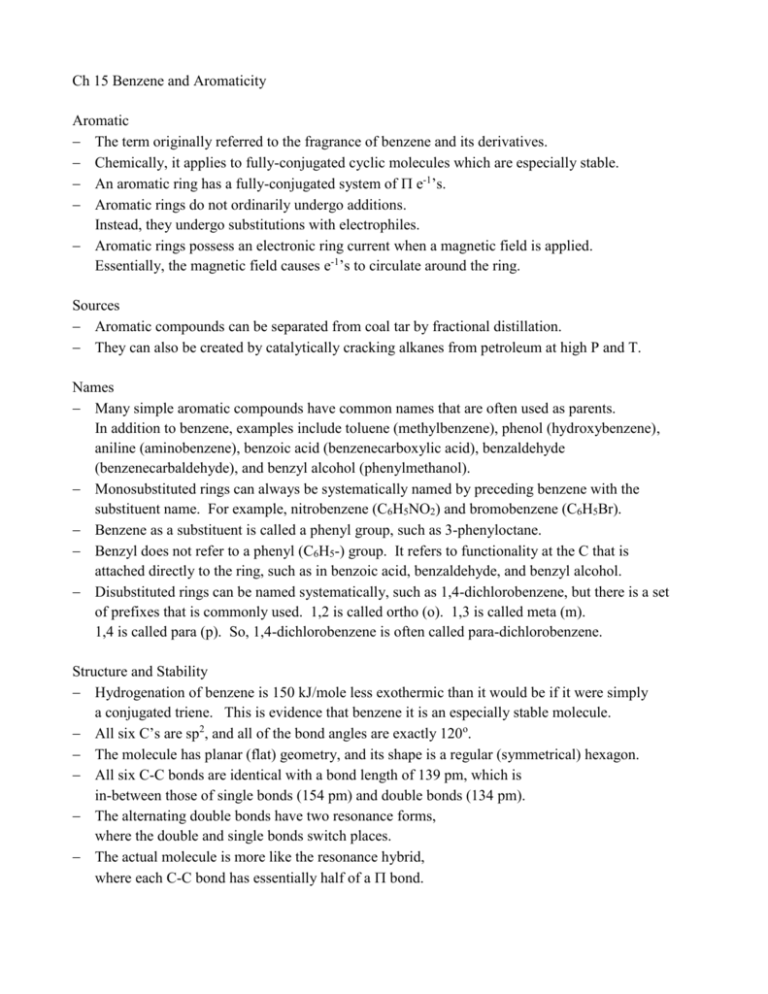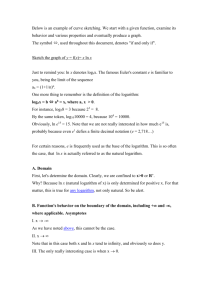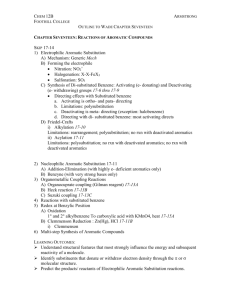Ch 15 Benzene and Aromaticity
advertisement

Ch 15 Benzene and Aromaticity Aromatic The term originally referred to the fragrance of benzene and its derivatives. Chemically, it applies to fully-conjugated cyclic molecules which are especially stable. An aromatic ring has a fully-conjugated system of e-1’s. Aromatic rings do not ordinarily undergo additions. Instead, they undergo substitutions with electrophiles. Aromatic rings possess an electronic ring current when a magnetic field is applied. Essentially, the magnetic field causes e-1’s to circulate around the ring. Sources Aromatic compounds can be separated from coal tar by fractional distillation. They can also be created by catalytically cracking alkanes from petroleum at high P and T. Names Many simple aromatic compounds have common names that are often used as parents. In addition to benzene, examples include toluene (methylbenzene), phenol (hydroxybenzene), aniline (aminobenzene), benzoic acid (benzenecarboxylic acid), benzaldehyde (benzenecarbaldehyde), and benzyl alcohol (phenylmethanol). Monosubstituted rings can always be systematically named by preceding benzene with the substituent name. For example, nitrobenzene (C6H5NO2) and bromobenzene (C6H5Br). Benzene as a substituent is called a phenyl group, such as 3-phenyloctane. Benzyl does not refer to a phenyl (C6H5-) group. It refers to functionality at the C that is attached directly to the ring, such as in benzoic acid, benzaldehyde, and benzyl alcohol. Disubstituted rings can be named systematically, such as 1,4-dichlorobenzene, but there is a set of prefixes that is commonly used. 1,2 is called ortho (o). 1,3 is called meta (m). 1,4 is called para (p). So, 1,4-dichlorobenzene is often called para-dichlorobenzene. Structure and Stability Hydrogenation of benzene is 150 kJ/mole less exothermic than it would be if it were simply a conjugated triene. This is evidence that benzene it is an especially stable molecule. All six C’s are sp2, and all of the bond angles are exactly 120o. The molecule has planar (flat) geometry, and its shape is a regular (symmetrical) hexagon. All six C-C bonds are identical with a bond length of 139 pm, which is in-between those of single bonds (154 pm) and double bonds (134 pm). The alternating double bonds have two resonance forms, where the double and single bonds switch places. The actual molecule is more like the resonance hybrid, where each C-C bond has essentially half of a bond. Molecular Orbital Description Each of the six C’s contributes one p e-1 and one p orbital, which creates six MO’s. Three of the MO’s are bonding (lower E) and are completely filled with the six e-1’s. The other three MO’s are anti-bonding (higher E) are completely empty. The lowest energy MO (1) has no nodes and is a completely continuous system, involving all six C’s with no separation. 2 and 3 have the same energy (this is called degenerate) and each MO has one node. They are not exactly identical because the nodal planes are in different locations. 4 and 5 are also degenerate (have the same energy) and each has two nodes. Again, they are not exactly identical because the nodal planes are in different locations. However, having two nodes creates more separation between MO’s, and these nodes create instability (anti-bonding). 6 has the highest energy and highest instability. It has three nodes, which completely separates all six C atoms and provides no bonding or stability. Aromaticity Not every fully-conjugated cyclic molecule is aromatic and stable. Stable aromatic molecules will have a total number of e-1’s that fits the equation 4n + 2. This is known as the Hückel rule. Benzene has six e-1’s. If n = 1, then 4n + 2 = 6, so benzene fits the Hückel rule. Cyclobutadiene and cyclooctatetrene have four and eight e-1’s, respectively. Four and eight fit 4n + 0 instead. These molecules are called anti-aromatic because they are especially unstable. Aromatic Ions The cyclopentadienyl anion has six e-1’s and is aromatic. Four e-1’s come from the two double bonds. The other two come from a lone pair on the fifth (anionic) C. On the cyclopentadiene molecule prior to ionization, the fifth C is sp3 and has 2 H’s. When one H+1 is removed from this C with NaOH, the C rehybridizes to sp2, and the lone pair becomes a p orbital. The cycloheptatrienyl cation also has six e-1’s, and is also aromatic. All six come from the three double bonds. On the cycloheptatriene molecule prior to ionization, the seventh C is sp3 and has 2 H’s. When an H-1 is removed from the C with Br2, the C rehybridizes to sp2, and the empty orbital becomes a p orbital. Aromatic Heterocycles (Pyridine and Pyrrole) Pyridine (C5H5N) is essentially a benzene ring where one C-H has been replaced with an N. The N is sp2, and one of the three sp2 orbitals is a lone pair. The N atom contributes one e-1 from its p orbital, making a total of six e-1’s for the molecule, which is aromatic. Pyrrole (C4H4NH) is a five-membered ring with two C-C double bonds. The C-C double bonds provide four e-1’s. The N is sp2 with three bonds and a lone pair in its p orbital. This lone pair contributes the other two e-1’s. So, the total is six e-1’s for the molecule, and it is aromatic. Why 4n+2? The lowest energy MO (1) is not degenerate, so only one MO (two e-1’s) has this energy. Every energy level above this, with the possible exception of the highest E anti-bonding MO, is doubly degenerate, meaning there are two MO’s (four e-1’s 1) with the same energy. So, there are two e-1’s at the lowest E level, and four e-1’s at each successive E level. The equation 4n+2 describes the number of e-1’s that completely fill the bonding orbitals and leaves the anti-bonding orbitals completely empty. Polycyclic (Naphthalene) Naphthalene is composed of two fused benzene rings, and it has a total of ten e-1’s. The Hückel rule is hard to apply because each ring would individually have five e-1’s. However, ten is a Hückel number (n=2), so the entire system is aromatic as a whole. The aromaticity can be seen more easily by looking at the two resonance forms. In each of the two forms, one of the two rings has six e-1’s and appears aromatic.









